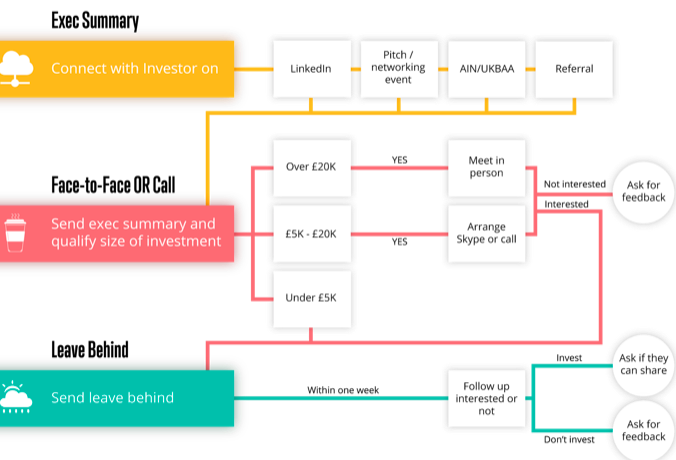For small business owners wanting to raise funds, one of the biggest barriers is having the right tools to support their pitch. There are lots of different opinions on what makes a good deck, much of it misguided and rooted in opinion rather than data.
 This article takes my experience of successfully funding around 50 companies and combines it with research completed by DocSend to find the perfect formula for an engaging, compelling and ultimately easy to digest deck.
This article takes my experience of successfully funding around 50 companies and combines it with research completed by DocSend to find the perfect formula for an engaging, compelling and ultimately easy to digest deck.
John Auckland from Tribe First highlights how you can create and deliver a killer pitch deck for your small business to secure funding.
Have at least three decks
A common misconception is that you should have just one deck, which is illogical. You engage with investors in a number of different ways, and your pitch decks need to reflect this. As a bare minimum you should prepare three different documents before you start reaching out to investors:
- The Investor Deck – is what most people create in an attempt to fit everything into one document. But, of course, if it’s the first thing an investor sees, there is no context, and so the chances of them getting to the core of your opportunity are slim at best. The Investor Deck should be treated as a leave behind only, not something you send out en-masse, or a document you present over.
- The Exec Summary – is a standalone teaser document that gives them everything they need to decide if they want to spend the time looking into the opportunity further.
- The Presentation Deck – a version of your pitch deck that has only images and no words at all, which is designed to be presented over, either in person or on a video conference. Do you remember the last time you saw a TED Talk with a wordy presentation? No, because they ban the use of any words in a presentation unless to highly emphasise a point. If you put words on a screen, people will read the words rather than listen to you
I’ve created a handy flow diagram that shows how and when these different documents are used. If you utilise these documents as they were meant to be used, and if you optimise them for that specific use, it will increase your investor engagement levels. I’ve been told (by some snobby investors who insist on industry norms, even if those traditions make no sense) that this approach slows the process down. That’s only true if you try to omit key information from the Exec Summary, or you present your pitch in the wrong order or rush through it without focusing on the detail.

Have your deck in the right order
It’s vital that you get the Investor Deck in the right order. You may also find it easier to put your Presentation Deck in the same order as well, but it’s not essential. And rather than employing guesswork, you can build your deck around a DocSend/Harvard Business School study into 200 startups that completed their Seed or Series A rounds. This study tracked the effectiveness of these 200 decks, and arrived at the following as an optimised order in which to put your slides:
- The Purpose – i.e. a summary of what you do and why they should care.
- The Problem – the problem you’re solving, or more accurately, the market opportunity you’re meeting (since you shouldn’t use negative language in a deck).
- The Solution – how your solution is uniquely placed in the market to solve this problem
- Why Now? – Why is this urgent now? Was the market not ready before? Did the technology not exist to allow it to happen? Are you an evolution or a revolution? These are all important points – ideas fail to manifest either because they’re bad ideas, or because the market wasn’t ready for them, or because they hadn’t been thought of before. You need to prove to an investor that you don’t fit into the first category. And if you fit in the latter category, you should have a logical argument for why they haven’t been thought of before.
- Market – a deeper dive into the size of the market, its trends and your potential penetration.
- Competition – who else is tackling this problem? Make sure you do extensive research because if your investor finds a competitor you missed, it’s a surefire way of them exiting the opportunity. In truth, you want some competitors because educating an entire market on your own is expensive, or it’s a sign that the market isn’t ready. And everyone has competition. The competitor to the first motorcar was a horse-drawn carriage.
- Product – a deeper dive into the product and any sales you’ve made so far. You need lots of evidence, stats and testimonials here if you can.
- Business Model – how do you make money now? How do you make it in the future? How do you market your product/services and how do those costs fit into the overall model?
- Team – this could arguably go higher in the deck, however, if you’ve produced a good Exec Summary and Presentation Deck, you’d have already told your personal eureka moment and how you brought other people into your journey. Wherever you place it, show how every team member is relevant, and if they don’t add value take them out (of your team and your deck). If your team is weak in any one area, find an advisor or Non-Exec Director to plug the gap.
- Financials – a financial summary, not ten pages of your entire financial model. Highlight the key areas of your financials and importantly show how and when the investor is likely to make a return.
Tell your story
Most advice focuses on the rational decision-making centre in an investor’s brain. However, investors are people, and the final decision as to whether they should invest is ultimately an emotional one. People relate to stories and narratives. These create empathy and build relationships, triggering all sorts of emotions as the investor imagines being in your shoes. Stories have structure – they have a beginning, a middle and an end. They have dramatic moments and interesting but relatable side anecdotes. They provide so much more flavour and texture to your pitch, which helps the investor form an opinion about you.
Make it about them
Pitch documents are, essentially, marketing materials, and even experienced marketers make the mistake of talking from their perspective rather than the customer’s (in your case the customer is an investor). Copywriters that get paid the big bucks have spent years refining this skill and can still get it wrong, so it’s not an easy task. However, there are some tips to help you deploy more empathy in your writing.
- Visualise your perfect investor and write your documents specifically for them. Even go so far as addressing them in the first person, using the word ‘you’ to get the copy to speak to them directly (stopping short of naming them, of course!).
- Read everything you write back out loud. If it sounds like a robot then the reader is less likely to engage with it. If it sounds like you’re having a conversation with them then they’re more likely to absorb themselves in what you’ve written.
- And while you’re reading everything back to yourself, ask yourself of every paragraph, ‘why should an investor care?’ If you don’t have an answer you can probably cut down that sentence or delete it entirely.
- Also use fewer, better words to get your point across. Strip as much as you can away without losing the meaning. Shorter copy is easier to absorb so it’s more likely the reader will make it all the way through.
- And personalise your deck, but that’s a big enough point to warrant its own section.
Personalise
Finally, do your research on the investor you’re meeting with and personalise your materials accordingly. It’s amazing how much you can find out from LinkedIn. If they seem like the type who invests more on a gut feeling, then put your team slides and backstory at the start. If they come across as more analytical or are known for having a scoring system for appraising new investment opportunities, focus more on the numbers, statistics and evidence. It’s a simple thing, but even putting their name on the front cover can have a profound effect.
If you follow these five steps, as the fifty or so companies we’ve helped fund did, then your chances of successfully finding an investor will increase.
More on pitching and small business funding.


Follow Company Bug